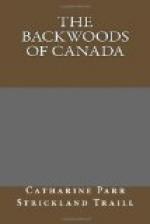I am anxiously looking forward to the spring, that I may get a garden laid out in front of the house; as I mean to cultivate some of the native fruits and flowers, which, I am sure, will improve greatly by culture. The strawberries that grow wild in our pastures, woods, and clearings, are several varieties, and bear abundantly. They make excellent preserves, and I mean to introduce beds of them into my garden. There is a pretty little wooded islet on our lake, that is called Strawberry island, another Raspberry island; they abound in a variety of fruits—wild grapes, raspberries, strawberries, black and red currants, a wild gooseberry, and a beautiful little trailing plant that bears white flowers like the raspberry, and a darkish purple fruit consisting of a few grains of a pleasant brisk acid, somewhat like in flavour to our dewberry, only not quite so sweet. The leaves of this plant are of a bright light green, in shape like the raspberry, to which it bears in some respects so great a resemblance (though it is not shrubby or thorny) that I have called it the “trailing raspberry.”
I suppose our scientific botanists in Britain would consider me very impertinent in bestowing names on the flowers and plants I meet with in these wild woods: I can only say, I am glad to discover the Canadian or even the Indian names if I can, and where they fail I consider myself free to become their floral godmother, and give them names of my own choosing.
Among our wild fruits we have plums, which, in some townships, are very fine and abundant; these make admirable preserves, especially when boiled in maple molasses, as is done by the American housewives. Wild cherries, also a sort called choke cherries, from their peculiar astringent qualities, high and low-bush cranberries, blackberries, which are brought by the Squaws in birch baskets,—all these are found on the plains and beaver meadows. The low-bush cranberries are brought in great quantities by the Indians to the towns and villages. They form a standing preserve on the tea-tables in most of the settlers’ houses; but for richness of flavour, and for beauty of appearance, I admire the high-bush cranberries; these are little sought after, on account of the large flat seeds, which prevent them from being used as a jam: the jelly, however, is delightful, both in colour and flavour.
The bush on which this cranberry grows resembles the guelder rose. The blossoms are pure white, and grow in loose umbels; they are very ornamental, when in bloom, to the woods and swamps, skirting the lakes. The berries are rather of a long oval, and of a brilliant scarlet, and when just touched by the frosts are semi-transparent, and look like pendent bunches of scarlet grapes.




